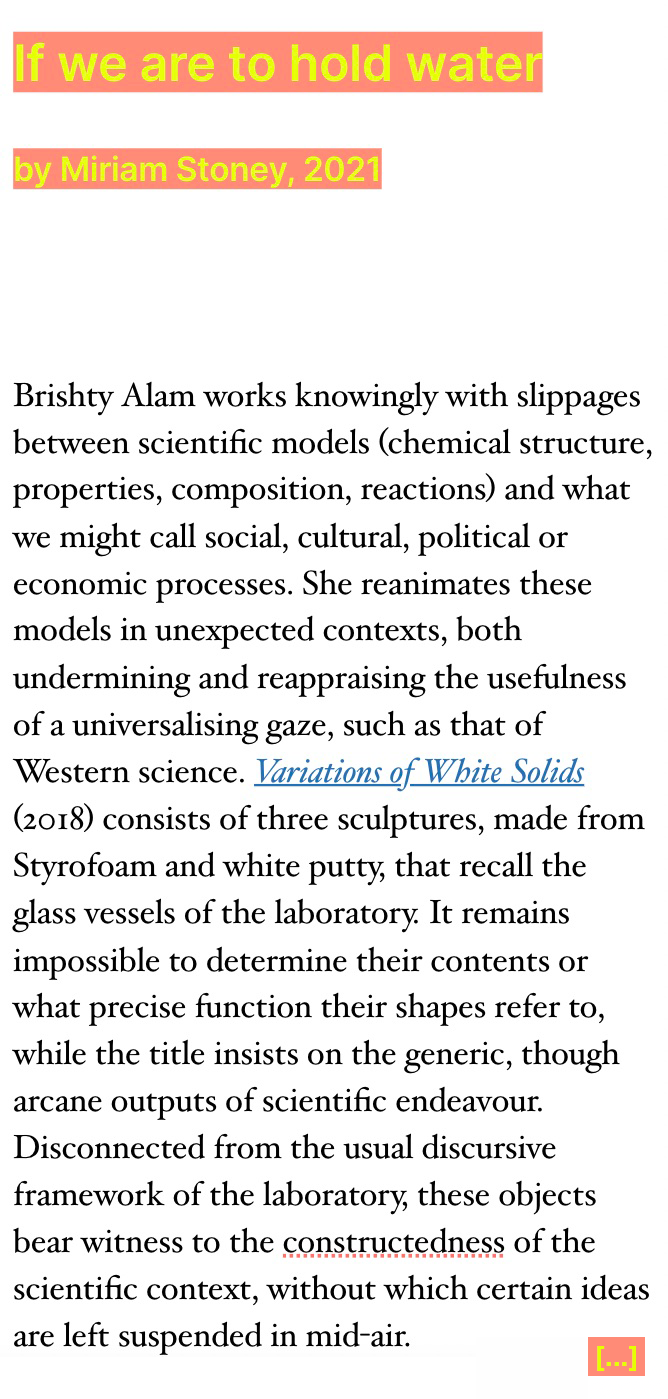If we are to hold water
by Miriam Stoney, 2021
Brishty Alam works knowingly with slippages between scientific models (chemical structure, properties, composition, reactions) and what we might call social, cultural, political or economic processes. She reanimates these models in unexpected contexts, both undermining and reappraising the usefulness of a universalising gaze, such as that of Western science. Variations of White Solids (2018) consists of three sculptures, made from Styrofoam and white putty, that recall the glass vessels of the laboratory. It remains impossible to determine their contents or what precise function their shapes refer to, while the title insists on the generic, though arcane outputs of scientific endeavour. Disconnected from the usual discursive framework of the laboratory, these objects bear witness to the constructedness of the scientific context, without which certain ideas are left suspended in mid-air.
The white spheres that make up Model-Sculpture (2014) appear to have evaporated from these solid vessels. These objects are animated in a series of video works that projects these white solids into other realities; for example, in If you come to the willow tree in the summer you feel rain (2018). Creeping along the forest floor, a body is augmented by three spheres: one large, where the head would be; two small, to replace the hands. By referring back to the Variations, sculptures of a chemical character become recognisable, so that we may perceive just three atoms floating through tropical vegetation. The visuals were filmed in the Brazilian rainforest, but the crunching sounds of footsteps in the mulch were recorded in Vorarlberg, an alpine region in western Austria. This coupling of sounds from Vorarlberg with the images of São Francisco Xavier invites us to consider the flow of water as a non-neutral, though indiscriminatory process of constant movement.
The Great Emigration (2012) offers a perspective on departure that is often otherwise neglected in favour of arrival narratives. The documentary-style voiceover articulates the trials of the young salmon in its passage from river to sea. The problem of retaining water in the fish’s body is critical in the transition from freshwater to saltwater. In a skewed parallel, the film shows a young woman, her brown face painted white, as she anticipates her departure. The language of the commentary, with its references to the salmon’s “lifestyle”, “culture” and “adjustment”, thus chimes with the keystones of human relocation. The slippage in this video suggests that we do not arrive somewhere unaffected, unscathed or unchanged. The very act of emigration exerts a particular force on the body, to which it must adapt if it hopes to survive: if we are to hold water.
Thus, the shape of a body responds to its present circumstances. Shutki is a Bengali word that describes a state of dryness, to the point of brittleness, but is also the name for dried fish or shrimp. The consumption of fish is a recurring motif in Brishty’s work, offering another basis of her sculptural investigations into shape, dimensionality, material and transcultural semiotics. Shutki (Lachsforelle) (2020) is one such example – made of unfired clay and wood, the battered fish shape moulds itself over and around large stones. EBI ICCHOOO! UNI ICCHOOO! TORO ICCHOOO! (2019) and Sashimi (2020) refer to Japanese specialities, sushi and sashimi, whose artful arrangement tend to detract from the organic realities of their ingredients. The weight of the fish slice forces it to warp around the stones on which they are placed. Sashimi uses masking tape, oil paint and charcoal to mark out the real dimensions of a tuna fish, made strangely spectral.
The oscillation in Brishty’s work, between these abstracted, aestheticized, fishly bodies and the videos’ highly specific, detailed accounts of life and existence, serves to unsettle the universalising implications of much ecological and diasporic discourse and re-engage art as a means of figuring interdependencies. Brishty herself uses the term ‘intermediate states’ to describe her process of working. In between states of transition, the work exists on an axis of continued reaction. Her role as an artist, then, is to look, to look closely, and then to keep on looking. Dekho ! Dekho ! Dekho ! (2020-2022) – “Look! Look! Look!” in Bengali – shows perhaps an unexpectedly domestic scene, in which a Bengali family celebrates an unspecified occasion. The highpoint of the festivities is echoed by video calls taking place around the room. We hear the repeated call, “Dekho!” which continues to reverberate throughout Brishty’s practice, as both linguistically specific and cross-culturally imperative.
